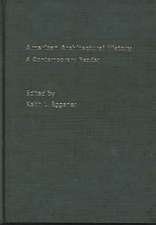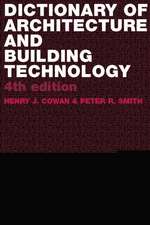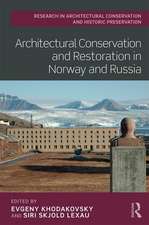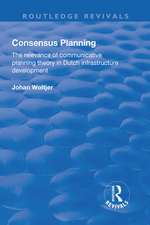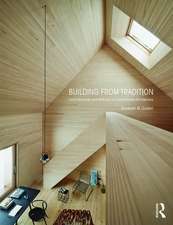The Recovery of Natural Environments in Architecture: Air, Comfort and Climate: BRI Research Series
Autor C. Alan Shorten Limba Engleză Hardback – 23 ian 2017
| Toate formatele și edițiile | Preț | Express |
|---|---|---|
| Paperback (1) | 516.14 lei 6-8 săpt. | |
| CRC Press – 20 ian 2017 | 516.14 lei 6-8 săpt. | |
| Hardback (1) | 860.79 lei 6-8 săpt. | |
| CRC Press – 23 ian 2017 | 860.79 lei 6-8 săpt. |
Preț: 860.79 lei
Preț vechi: 1148.10 lei
-25% Nou
Puncte Express: 1291
Preț estimativ în valută:
164.71€ • 172.43$ • 136.29£
164.71€ • 172.43$ • 136.29£
Carte tipărită la comandă
Livrare economică 05-19 aprilie
Preluare comenzi: 021 569.72.76
Specificații
ISBN-13: 9780415824408
ISBN-10: 0415824400
Pagini: 404
Ilustrații: 309
Dimensiuni: 189 x 246 x 25 mm
Greutate: 1.18 kg
Ediția:1
Editura: CRC Press
Colecția Routledge
Seria BRI Research Series
ISBN-10: 0415824400
Pagini: 404
Ilustrații: 309
Dimensiuni: 189 x 246 x 25 mm
Greutate: 1.18 kg
Ediția:1
Editura: CRC Press
Colecția Routledge
Seria BRI Research Series
Public țintă
Professional and Professional Practice & DevelopmentCuprins
1. Airs, Fears, Dangers 2. Climate and its Annihilation 3. Temperate Climates 4. Urban Heat Islands 5. Theatres 6. Hospitals 7. Mediterranean climates 8. Continental climates 9. Existing buildings 10. Delivering the ‘Recovery’
Notă biografică
C. Alan Short was educated at Trinity College Cambridge and Harvard University’s Graduate School of Design. He has been the Professor of Architecture at the University of Cambridge since 2001 and his work focuses on the design of sustainable buildings. He will become the ninth President of Clare Hall Cambridge in August 2020, a seven year term. He has also designed a sequence of very low energy buildings, one of very few architects in the UK deeply involved in Higher Education and Research.
Recenzii
"This is really wonderful work. This unique and remarkable synthesis of three decades’ unrivaled innovation rediscovers, refines, and modernizes the ancient art of natural ventilation. It masterfully teaches how to make our buildings airy, healthful, and delightful, not by brute force but by sensitive and sensible design. All who breathe for our living will be forever in Professor Short’s debt. "
Amory B. Lovins, Hon AIA, Co-founder and chief scientist, Rocky Mountain Institute
"By re-connecting architecture to the provision of thermal comfort, The Recovery of Natural Environments in Architecture: Air, Comfort and Climate offers valuable strategic direction on avoiding energy-intensive air-conditioning in the face of increasing urban temperatures. Alan Short, an accomplished researcher and practitioner, positions his remarkable portfolio of naturally conditioned buildings within a rich historical context, giving the book appeal beyond those directly involved with architectural education and practice. Giving architectural form meaningful environmental intent, learning from continual experimentation and offering frank accounts of success and failure, are seldom as well documented or made accessible as in this insightful book."
Raymond J. Cole, Professor of Architecture, University of British Columbia, Canada
"A revolutionary and challenging examination of the history and the present state of building design and the relationship to the environment and most importantly, the people who reside inside. A new view is offered of "modern determinism" and the issues of climate, weather and air and how they should be reconsidered, not just as "green" or "style" but as a social practice. Do we really need all glass and air conditioners? Illuminated in wonderful detail is a new understanding of the past and our present problems and a view of a way forward. Offered is a new thinking about design and the need for change."
Richard Guy Wilson, Commonwealth Professor of Architectural History, University of Virginia
"This well structured book is easy to read and, instead of concentrating large chunks on individual case studies, the author brings them in when relevant. The flexible chapter structure allows the author to explore his specific interest in what are arguably some of the most challenging building types for natural ventilation and passive design – multi-storey offices in urban locations, theatres, hospitals and laboratories – while interspersing informative historical, scientific and architectural practice facts, making for a detailed and engaging narrative."
RIBA Journal, March 2017
"This book is a tour de force in holistic human thought in which the divisions between the arts, engineering and science dissolve before your very eyes. A lesson for education and the professional institutions lies here... But there is a real purpose too-- to reconnect our architecture with the natural world for the benefit of people and not for this ideal to subsumed by the force of technology."
Intelligent Buildings International, April 2017
"This book has opened my eyes to the idea that architecture needs to be more isolationist and less interactive. Once an architect has taken on the client brief then modifications should be by fellow professionals, to ensure we have a healthy built environment. This book is well written, factual and full of meaningful explanations with related, in-depth case studies, and I really enjoyed reading it. My business partner states: 'You can do anything with a building as long as you can afford it' - I feel this book is trying to ensure we look at 'afford' as an environmental flag, not financial."
Building Engineer, August 2017
"What we are now relearning is that humans actually perform better in spaces with variable thermal conditions, and that we definitely do better with high air circulation and less CO2 in the air. But, can that be achieved without chillers, fans and other complex energy intensive mechanical equipment? The answer is emphatically yes. For more than three decades C. Alan Short, has been designing remarkable naturally ventilated buildings. Some are as visually complex as the work of the deconstructivist architects, yet their forms are derived from complex fluid dynamics modeling. Short’s buildings are large and span a variety of types and climates. I have had the pleasure spending some time in three of them… Short details the design and engineering of these and other projects in his new book... This work is very encouraging as it will not only lower energy costs and improve ventilation, it also offers a new level of resilience when conventional systems fail. In the hot late days of summer, this is an important book to read."
Bill Browning, https://www.terrapinbrightgreen.com/blog/2017/08/natural-ventilation-learning-past/
"Short writes broadly across contemporary programs and climate types. More than "case studies," these detailed narratives explicate the emergence of the projects’ technical, aesthetic, financial, and functional aspects. The chapters on theatres and hospitals should be required reading for studios broaching either type. Short intuits that change is coming to both the architectural zeitgeist and the earth’s climate. He argues that naturally-conditioned buildings will have greater viability as the climate warms, and find applicability across larger territories. His is a cautiously optimistic tone. He writes near the end of the book 'Might it be that widespread disenchantment will arise with sealed artificial environments, the potential implications for health and well-being, revulsion at the profligacy in energy and carbon, and realization that homogenized and insubstantial transparent building forms no longer capture the ‘spirit of the age’?' Let it be so. If you, like this reviewer, have toiled to educate thermodynamically and mechanically literate architects while shunning the model of exquisitely tempered sealed boxes, read this book."
Martha Bohm, University at Buffalo, SUNY, USA in SBSE News Summer 2017
"This is a superb book, as well as very unusual one. It is really rare to find a practising academic architect who is highly erudite and so steeped in culture and history, as well as in the technical matter of managing the largely passive movement of large amounts of air in an economic and environmentally acceptable manner in today’s world. Short’s buildings… represent a more hopeful and engaged future."
Colin Porteous, Mackintosh School of Architecture, Glasgow School of Art, Glasgow, UK, Citation: Colin Porteous (2018): The significance of natural ventilation, Building Research & Information, DOI: 10.1080/09613218.2018.1500005
Amory B. Lovins, Hon AIA, Co-founder and chief scientist, Rocky Mountain Institute
"By re-connecting architecture to the provision of thermal comfort, The Recovery of Natural Environments in Architecture: Air, Comfort and Climate offers valuable strategic direction on avoiding energy-intensive air-conditioning in the face of increasing urban temperatures. Alan Short, an accomplished researcher and practitioner, positions his remarkable portfolio of naturally conditioned buildings within a rich historical context, giving the book appeal beyond those directly involved with architectural education and practice. Giving architectural form meaningful environmental intent, learning from continual experimentation and offering frank accounts of success and failure, are seldom as well documented or made accessible as in this insightful book."
Raymond J. Cole, Professor of Architecture, University of British Columbia, Canada
"A revolutionary and challenging examination of the history and the present state of building design and the relationship to the environment and most importantly, the people who reside inside. A new view is offered of "modern determinism" and the issues of climate, weather and air and how they should be reconsidered, not just as "green" or "style" but as a social practice. Do we really need all glass and air conditioners? Illuminated in wonderful detail is a new understanding of the past and our present problems and a view of a way forward. Offered is a new thinking about design and the need for change."
Richard Guy Wilson, Commonwealth Professor of Architectural History, University of Virginia
"This well structured book is easy to read and, instead of concentrating large chunks on individual case studies, the author brings them in when relevant. The flexible chapter structure allows the author to explore his specific interest in what are arguably some of the most challenging building types for natural ventilation and passive design – multi-storey offices in urban locations, theatres, hospitals and laboratories – while interspersing informative historical, scientific and architectural practice facts, making for a detailed and engaging narrative."
RIBA Journal, March 2017
"This book is a tour de force in holistic human thought in which the divisions between the arts, engineering and science dissolve before your very eyes. A lesson for education and the professional institutions lies here... But there is a real purpose too-- to reconnect our architecture with the natural world for the benefit of people and not for this ideal to subsumed by the force of technology."
Intelligent Buildings International, April 2017
"This book has opened my eyes to the idea that architecture needs to be more isolationist and less interactive. Once an architect has taken on the client brief then modifications should be by fellow professionals, to ensure we have a healthy built environment. This book is well written, factual and full of meaningful explanations with related, in-depth case studies, and I really enjoyed reading it. My business partner states: 'You can do anything with a building as long as you can afford it' - I feel this book is trying to ensure we look at 'afford' as an environmental flag, not financial."
Building Engineer, August 2017
"What we are now relearning is that humans actually perform better in spaces with variable thermal conditions, and that we definitely do better with high air circulation and less CO2 in the air. But, can that be achieved without chillers, fans and other complex energy intensive mechanical equipment? The answer is emphatically yes. For more than three decades C. Alan Short, has been designing remarkable naturally ventilated buildings. Some are as visually complex as the work of the deconstructivist architects, yet their forms are derived from complex fluid dynamics modeling. Short’s buildings are large and span a variety of types and climates. I have had the pleasure spending some time in three of them… Short details the design and engineering of these and other projects in his new book... This work is very encouraging as it will not only lower energy costs and improve ventilation, it also offers a new level of resilience when conventional systems fail. In the hot late days of summer, this is an important book to read."
Bill Browning, https://www.terrapinbrightgreen.com/blog/2017/08/natural-ventilation-learning-past/
"Short writes broadly across contemporary programs and climate types. More than "case studies," these detailed narratives explicate the emergence of the projects’ technical, aesthetic, financial, and functional aspects. The chapters on theatres and hospitals should be required reading for studios broaching either type. Short intuits that change is coming to both the architectural zeitgeist and the earth’s climate. He argues that naturally-conditioned buildings will have greater viability as the climate warms, and find applicability across larger territories. His is a cautiously optimistic tone. He writes near the end of the book 'Might it be that widespread disenchantment will arise with sealed artificial environments, the potential implications for health and well-being, revulsion at the profligacy in energy and carbon, and realization that homogenized and insubstantial transparent building forms no longer capture the ‘spirit of the age’?' Let it be so. If you, like this reviewer, have toiled to educate thermodynamically and mechanically literate architects while shunning the model of exquisitely tempered sealed boxes, read this book."
Martha Bohm, University at Buffalo, SUNY, USA in SBSE News Summer 2017
"This is a superb book, as well as very unusual one. It is really rare to find a practising academic architect who is highly erudite and so steeped in culture and history, as well as in the technical matter of managing the largely passive movement of large amounts of air in an economic and environmentally acceptable manner in today’s world. Short’s buildings… represent a more hopeful and engaged future."
Colin Porteous, Mackintosh School of Architecture, Glasgow School of Art, Glasgow, UK, Citation: Colin Porteous (2018): The significance of natural ventilation, Building Research & Information, DOI: 10.1080/09613218.2018.1500005
Descriere
The Recovery of Natural Environments in Architecture challenges the modern practice of sealing up and mechanically cooling public scaled buildings in whichever climate and environment they are located. This book unravels the extremely complex history of understanding and perception of air, bad air, miasmas, airborne pathogens, beneficial thermal conditions, ideal climates and climate determinism.







